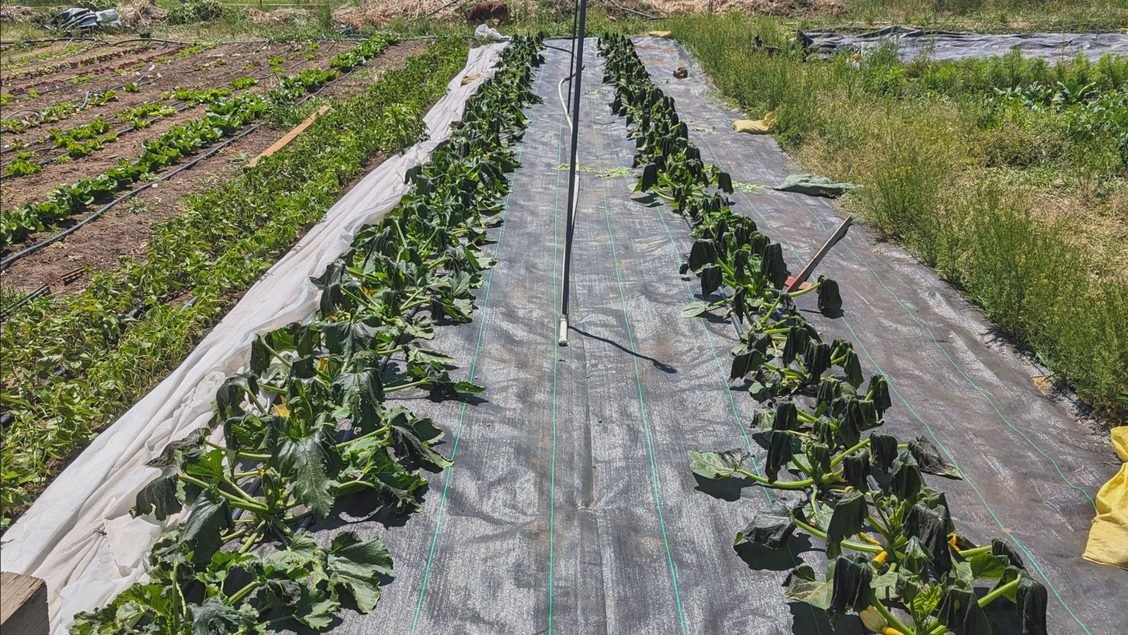“We Will Get By, We Will Survive.”
Happy Summer!
Everything is looking and tasting pretty good here on the farm. We’ve had some sweet, crispy, hefty lettuce heads and our salads have been bangin’. The green and purple beans just keep on yielding, the radishes are solid and our cucumber plants definitely deliver. The long-awaited tomato plants are a tad later than we had predicted, however they will be ready for our CSA Members this week! The garlic harvest is about to begin too and we are anticipating raspberries any day now.
There is so much “growing on” but at the same time we have experienced a lot of loss. Managing every crop all at once can be a challenge, especially when the weather is not on your side and a never-ending battle with weeds. .
Here in Bend, OR, a two-day deep frost visited the farm right before the Summer Solstice with temperatures as low as 27 degrees. Apparently, frost has preyed upon Central Oregon on the third week of June for the past three years. Then the following week, temperatures rose over 90 degrees. Every day since then, the weather has reminded us that Summer has indeed arrived. The sun is “cranking” by 10 am. We are constantly watering the field including cooling our lettuce with overhead irrigation so they don’t immediately bolt. The majority of tasks to accomplish right now require a combination of light + cool temperatures. This happens only from 4:30 am to no later than 12 pm. By the time it gets cooler in the evening you need a headlamp to work and honestly… we’re just ready for bed.
In this high desert climate, these temperature swings can really mess up a plant’s day. During that frost we had major hits to our: potatoes, winter squash, watermelon, basil, summer squash, bush beans, including flowers such as some cosmos, zinnias, more basil, tall grasses, dahlias and gomphrena. Our summer squash looked VERY SAD. The big, vibrant green, elephant ear shaped leaves now looked like black draping bat wings that drooped from it’s stems. The basil and cosmos looked as if they had gone through a brush fire. We utilized as much preventative practices as possible by covering the outdoor sun loving crops with our inadequate supply of frost cloth. At 1 am we needed to troubleshoot the heater for our greenhouse when our alarm notified us that the temps inside were below 45 degrees. We had also set up a sprinkler to hit the winter squash and potatoes in the front field once the temps dropped to freezing. If you keep the sprinkler running, water freezes onto the plant which then protects the plant from frost. Who would have thought?! However, we woke up to the sprinkler no longer running because it lost pressure and triggered the automatic shut off valve.
So much frost damage… we thought we were doomed. These were all important crops and time was not available to start over and reseed what was lost.
But in just a short amount of time, we were witnessing plants we thought were lost in our front field were actually coming back to life. With just a handful more starts purchased from a neighboring farm, our winter squash crop is now back on track! We were also gifted some cantelopes to replace the damaged watermelon and our potato crop now is looking stronger than ever.
In the main garden the summer squash is now flourishing. We were amazed to see them come back so quickly. The bush beans, cosmos and dahlias are now doing great too. There were some crops gone for good like the outdoor zinnias and basil. Thankfully, we have 40 ft of Zinnias growing in one of our greenhouses as a backup and basil grows quickly so we were able to sow more trays and will get them in the ground this week.
Plants have the ability to adjust to the most extreme weather conditions. They have such a high level of adaptation, that in case of an emergency, they are ready to sacrifice a part of themselves to survive and grow again. A plant’s reason for living is to grow, and growth needs resilience. If they don’t grow, they will die. If the plant is in the right environment, it is bound to grow and multiply. If a plant has strong roots, it can stay grounded and have stability.
These plants definitely deserve our admiration.
Another challenge we’re facing as organic farmers is weed pressure. The blazing hot temps and excessive watering supports all plant growth. Our excitement for fruit such as berries, tomatoes and squash does not make up for the anguish we face from these over-bearing weeds. Most large, non-organic farms will spray their crops with weed killers to get rid of this problem. Herbicides absorb into the soil and into your food. Then the bees pollinate the herbicide-covered plants, in-taking those harsh chemicals which can more than likely kill the swarm.
Tilling a crop just puts the seeds right back into your garden’s seed bank then grows back year after year. Our plan, when it comes to no-till, organic farming, is to cultivate daily, pull out large weeds by hand and remove plants before they go to seed so ultimately you’ll have a weed-free garden. It takes some seasons to get there, but there are some successful farms that currently work weed-free which we will continue to work towards.
Our additional labor has been drastically reduced. Last year we had two, full-time interns for three months solid. This year we forfeited additional labor to pay for business investments and have gone down to just 16 hours of part-time help. We figured we could make it happen since we consolidated the farm, but our schedule is still jam-packed. This year, our outlets of distribution are two farmers markets plus growing a combination of vegetables, flowers and harvesting eggs for 50 CSA Families per week. Although we only farm just over one acre of land, our full schedule of Farmers Markets and CSA has been a lot to carry with just the two of us
For right now, our schedule needs to stay the way it is until next season - we’re locked in. But we continue to think of ways on how we can improve our quality of life and to keep this farm sustainable for seasons to come.
One of our value’s is to make food accessible to everyone in our local community. We do this by keeping our CSA Membership at an affordable price, accepting food stamps and offering farm work trade for vegetables. Work Trade is a great way for the community to work on the farm and have access to local, organic produce. This has been a saving grace for us to acquire the additional labor needed to help us on the farm and with the harvests.
Even with all the loss, extreme weather, and the never-ending, daily, intensive physical labor, we still seem to have grown more food than ever! We’ve been really good at harvesting everything we have and finding it a home. Any un-sellable crop waste gets fed to our chickens and whatever isn’t sold at market gets donated to the Oregon Food bank. All the head lettuce we planted is being picked before it bolts from the heat. No food is going to waste. Inter-planting crops such as herbs, scallions and beans has also helped us to “max-out” a single bed’s production. This has created us to have more crops available in a smaller space and has helped increase the profitability of that bed.
It is absolutely impossible to not have crop loss which is why it is important for us to have diversity on the farm. The actual definition of “Diversification” is an increase in the variety of something. It also means: an investing technique used to reduce the chances of experiencing large losses by improving potential returns and stabilizing results. We will always have another crop to fall back on because we have a diversified farm.






